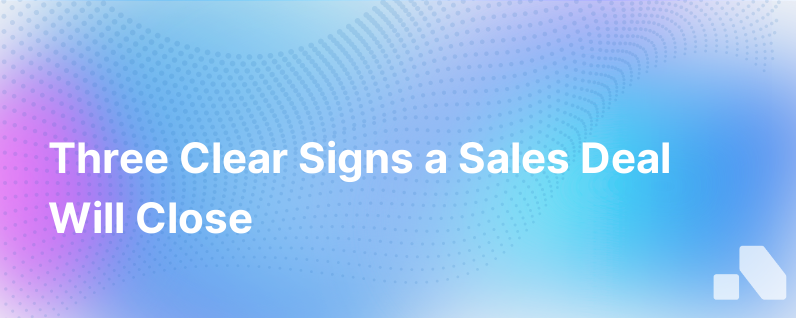The Three Signs A Deal Will Close
Published on September 1, 2023 by Sawyer Middeleer
In the complex terrain of B2B sales, discerning whether a prospective deal will close can sometimes feel more like the work of a soothsayer than a salesperson. But beyond intuition and hope, there are tangible signs that can signal when a deal is on the brink of fruition. In this exploration into sales foretelling, we'll dissect the three definitive signs that indicate a deal will close, guiding sales professionals to hone their focus and drive revenue with precision.
1. Aligned Understanding and Shared Vision
One of the most potent predictors of deal closure is the establishment of a shared vision between a potential client and your organization. When sales professionals effectively communicate the value proposition, and it resonates with the prospect's pain points and goals, you enter into a dynamic of mutual understanding. It means your narrative isn't just heard; it's felt and integrated into their vision of success.
But how does this manifest concretely within the sales process? Look for:
- Your Contact's Engagement: Are they prompt in their responses? Do their communications infer excitement or keen interest in the dialogue?
- Deep Dives into Product or Service Details: Prospects asking detailed questions indicate they are envisioning the solution in their environment.
- Usage of Collective Terms Like "We" and "Us": This linguistic shift from “you” and “I” to “us” is often an unconscious but telling sign that the prospect is already seeing your companies working together.
- Client Narrative Echo: If your prospect starts using your product’s vocabulary to describe their processes or problems, it is a good indicator they are integrating your solution into their business framework mentally.
2. The Engagement of Decision-Makers
It's one thing for your contact at a prospective company to be enthusiastic about your offerings, but if the decision-makers aren't engaged, the process is akin to sailing without wind. When you notice that the higher-ups — those holding the purse strings and strategic decision-making power — start to get involved, that's when you know a deal is picking up real momentum. The meeting invites get sent out to senior management, and the discussions elevate from tactical to strategic.
Key indications include:
- Executives Joining Calls or Meetings: If the C-suite or department heads are coming to the table, it's likely they are considering how your solution can strategically fit into their organization.
- Ask for References or Case Studies: When they start to solicit proof of effectiveness and ROI from similar deployments or customers, it’s because they’re validating the decision they’re leaning towards making.
- Direct Questions about Implementation & Long-Term Support: These questions indicate they are already in the planning stages of incorporating your solution, mentally crossing the bridge from contemplation to action.
- Negotiation Talks Begin: Delving into terms and pricing structures often denotes a serious shift from curiosity to intent.
3. Clear Passage Through the Procurement Process
The final hurdle in any B2B sales process is often the procurement and legal departments, where deals can languish in the purgatory of red tape. Evidence that a deal will close often comes from a smooth and facilitated process during these final stages.
Signs to watch for include:
- Efficient Legal Reviews: If legal documents, such as contracts or service agreements, are moving through review stages at a steady pace, it's a positive sign.
- Consistent Momentum: Even if the process is lengthy, consistent forward movement—prompt returns of requested information, scheduled check-ins—points toward a successful conclusion.
- Budget Discussions and Financial Planning: Talks about budget allocation, payment schedules, or purchase orders indicate that the company is financially committing to the partnership.
- Open Information Sharing: When procurement shares their process, timelines, or any bottlenecks candidly, it suggests they are working towards a solution, not creating obstacles.
Integrating Signals into A Proactive Sales Strategy
Recognizing these signals is just one part of a successful sales strategy. To capitalize on them, a sales team should ensure:
- High-level engagement is maintained through consistent follow-ups and delivering value in every interaction.
- Any objection or concern is robustly addressed to prevent derailing the deal at the final stages.
- Establish a clear roadmap for post-closure, ensuring that the buyer remains confident in the decision after the purchase is completed.
Incorporating Technology like Aomni for Enhanced Deal Prediction
In the evolving landscape of B2B sales, Artificial Intelligence and machine learning tools like Aomni can significantly boost a sales team's ability to predict deal closures. By analyzing data from CRM systems and previous sales outcomes, platforms like Aomni provide actionable insights, highlighting patterns that indicate deal progression. They serve to amplify human intuition and experience, giving sales teams a competitive edge in forecasting and resource allocation.
Conclusion
Recognizing the signs that a potential B2B sale is likely to close is an invaluable skill, saving time and resources while boosting conversion rates. Keep an eye out for synergistic understanding, engagement from decision-makers, and smooth progress through procurement. Leveraging these signals, coupled with tools like Aomni, will not only help sales teams close more deals but also do so with greater efficiency. In the intricate dance of B2B sales, understanding the rhythm is half the battle won.